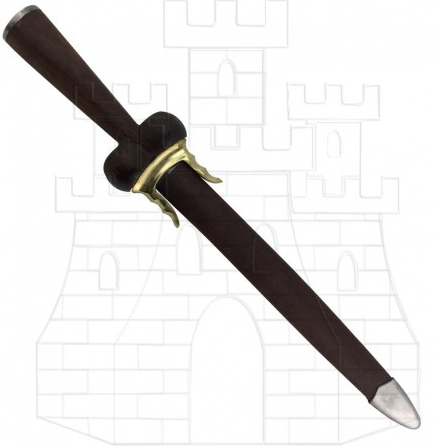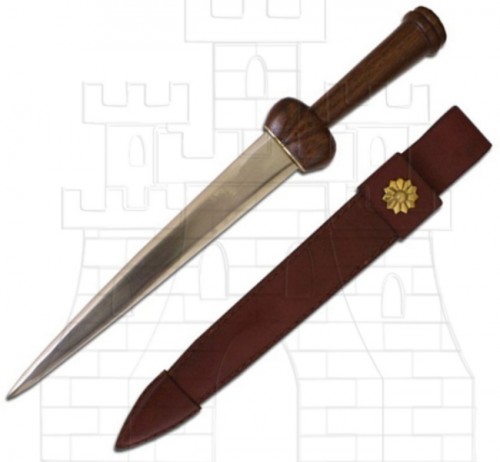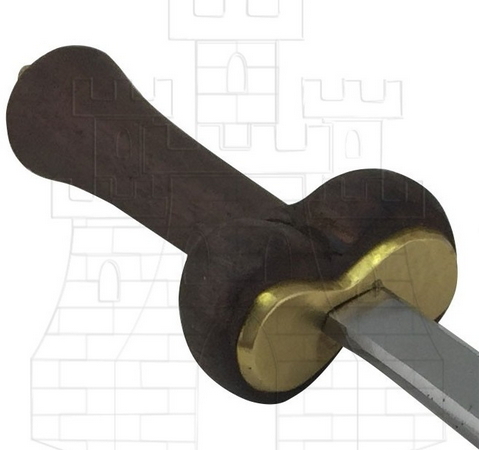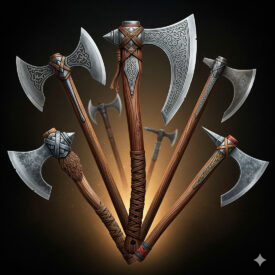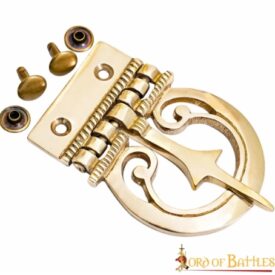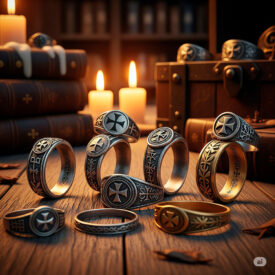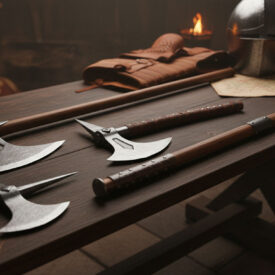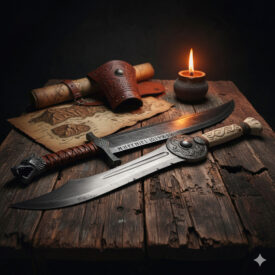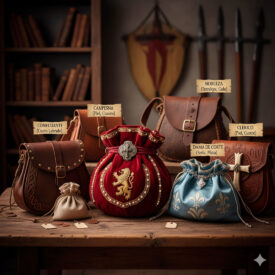What medieval weapon was versatile enough to accompany noble knights in the heat of battle as well as peasants in their daily tasks, and whose name caused so much modesty in the Victorian era that historians decided to rename it? The answer is the testicular dagger, one of the most iconic, durable, and widely used bladed weapons in medieval Europe.
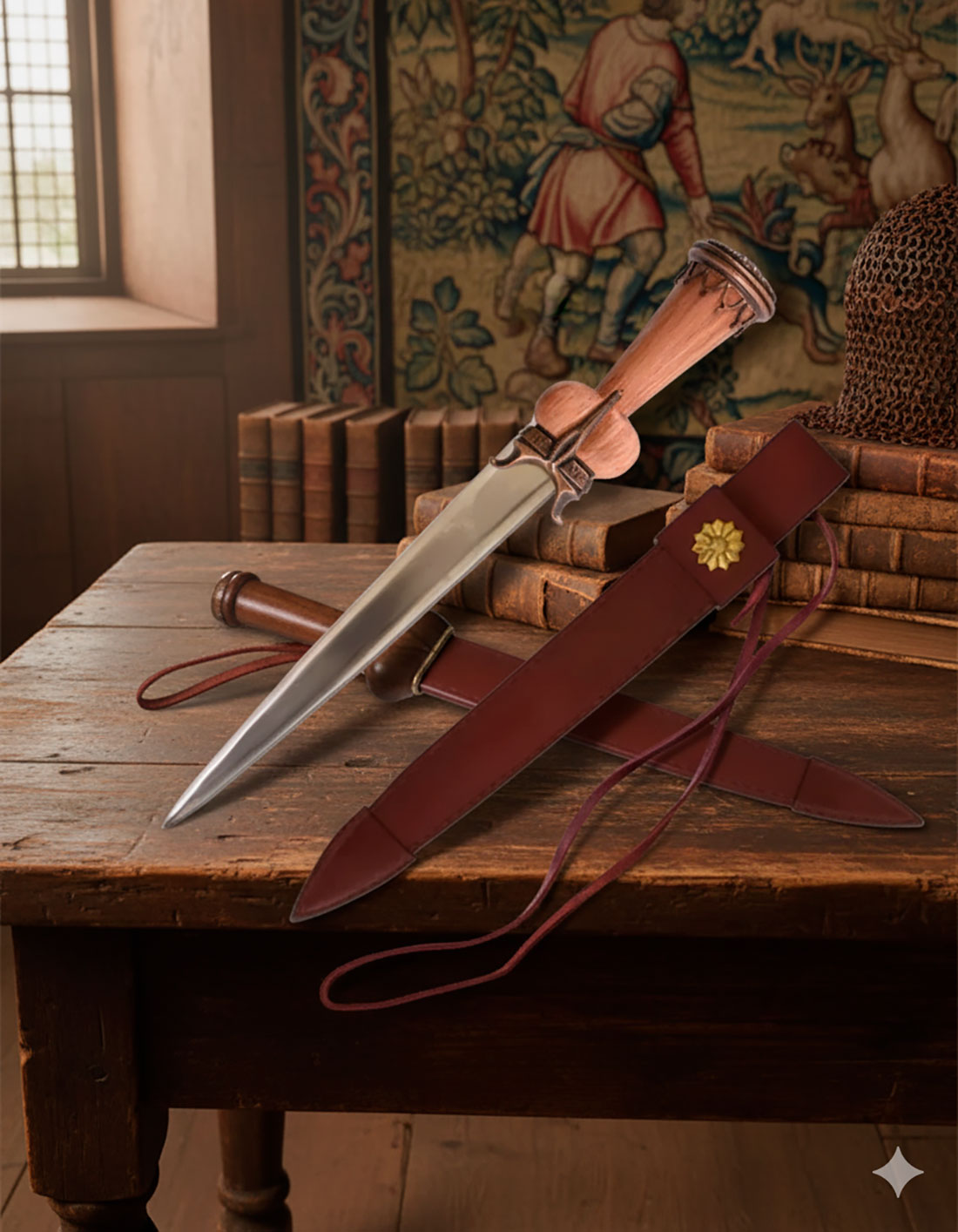
Known in English as bollock dagger or ballock knife, this weapon owes its name to the peculiar anatomy of its hilt: two ovoid protuberances flanking the handle that unequivocally recall male anatomy. Far from being a mere aesthetic whim, this distinctive design became a symbol of status, masculinity, and functionality that crossed the social and geographical borders of Europe for more than five centuries.
In this article, you will discover the fascinating history of testicular daggers, from their origins in the 13th century to their evolution into the Scottish dirk in the 18th century. You will learn about the technical characteristics that made it so effective in combat, its dual function as a defensive weapon and everyday tool, and understand why this singular design remained valid for so long in an era of constant armament innovations.
The name that made Victorians blush: nomenclature and etymology
A testicular dagger is a class of European dagger whose denomination has generated both fascination and modesty throughout history. Its main name comes directly from the artistic shape of its hilt, which features two ovoid protuberances or rounded lobes on the pommel, near the guard, that simulate testicles. This unmistakable anatomy gives it an unequivocally phallic shape that became its hallmark.
The many names of one weapon
Throughout the centuries, this weapon has received multiple denominations according to the region, language, and especially, the level of modesty of the person naming it:
- Bollock dagger or ballock knife: The original English term, derived directly from the word bollocks (testicles), used since the Middle Ages.
- Kidney dagger: During the Victorian era, weapon historians introduced this euphemism to avoid any sexual connotation. The argument was that the crossguard could resemble the shape of a kidney when viewed as a whole.
- Daga de bullones or daga almarada: Denominations used in Spanish in various historical contexts.
- Dudgeon dagger: In the 16th and 17th centuries, it was so called because the hilt was frequently made from boxwood root, known in English as dudgeon.
- Other European names: In Portuguese it was known as adaga colhona; in French, dague á couilettes; and in Scandinavian contexts, testikeldolk was proposed, although it never became as popular as nyredolk (kidney dagger).
This variety of names reflects not only the linguistic and cultural differences of Europe but also the changing social attitudes towards sexuality and decorum throughout the centuries.
The testicular dagger: historical trajectory and transformations
The so-called bollock dagger or ballock knife —euphemistically later known as a kidney dagger— is a type of European dagger whose two-lobed hilt made it recognizable and durable. Its documented use spans from the High Middle Ages to persistent forms in the 19th century, linking it to the evolution of weaponry, fashion, and terminology.
| Era | Event |
|---|---|
| Origin and High Middle Ages (13th–14th centuries) | |
| c. 1230 | The “Kristina Psalter” contains an illustration usually identified as the earliest representation of a kidney dagger (although some scholars compare it to an earlier cultellus). |
| Late 13th century | The testicular dagger emerges in England, Flanders, and Scotland, establishing its characteristic lobed hilt morphology. |
| 1300–1350 | The dagger begins to appear on continental effigies; it consolidates as a European type originating in the High Middle Ages. |
| Late 13th century – 14th century | It becomes the most common type of dagger in the Nordic countries, extending its use in Scandinavia. |
| High Late Middle Ages (14th–15th centuries) | |
| 14th century | The design is closely linked to the military equipment of the time, especially the plate armor that became popular in this century; the dagger is mainly used for thrusts. |
| 1360s | The dagger depicted on Duke Christoffer’s tomb in Roskilde Cathedral is the oldest securely dated kidney dagger in Denmark. |
| c. 1375 | Valdemar Atterdag appears with a kidney dagger in a fresco in Skt. Peders Church (Næstved); the example shows a conical hilt typical of the 14th century. |
| Last quarter of the 14th century – late 15th century | A dagger from the catalog (Moesgård, no. 6) is dated to this period by the shape of its hilt; another example found in Fruering (no. 2) is typologized in the late 14th century. |
| 1412–1421 | A testicular dagger is illustrated as part of a knight’s attire in Les Très Riches Heures du Duc de Berry, demonstrating its use as a status accessory. |
| 15th century | The kidney dagger also becomes a fashion accessory; it appears among the wide variety of daggers intended for thrusting. |
| Mid-15th century | In northern Italy, the stiletto emerges, while testicular daggers remain among the popular types for thrusts. |
| Second half of the 15th century (dendrochronological dating) | A fragment of a kidney dagger hilt found in Århus (no. 7) is dated to the second half of the 15th century; the twisted hilt is typologically identified in this period. |
| 1450–1500 | A similar French dagger in the Metropolitan Museum of Art is dated within this interval. |
| Renaissance and later periods (16th–19th centuries) | |
| Late 15th century – early 16th century | The testicular dagger maintains popularity in England during the Tudor and Stuart periods. |
| c. 1500 | There is an example of a ballock dagger dated around 1500 in England. |
| c. 1520 | A bollock dagger of iron, wood, and copper alloy —possibly French or German— is dated around 1520. |
| c. 1536–1538 | Hans Holbein the Younger makes a guard design for a bollock dagger, reflecting the continuity of the type in the Renaissance. |
| Mid-16th century | Daggers found in Ulstrup (no. 9) and Randers (no. 3) are typologically dated to around the mid-16th century. |
| 16th–17th centuries | The weapon is sometimes called a dudgeon dagger or dudgeon-hafted dagger, as many hilts are made of boxwood root (dudgeon). |
| Late 16th century – c. 1603 | The derived form, the dudgeon dagger (descendant of the ballock), becomes popular in Scotland towards the end of the 16th century and around 1603. |
| 17th–18th centuries | The design gradually evolves into the Scottish dirk, which maintains the general shape but with less prominent lobes. |
| 19th century | Although less predominant, the shape of the testicular dagger persists in various variants until the 19th century. |
| Terminological evolution | |
| Medieval use | The original name ballock dagger or bollock dagger comes from the shape of the hilt with two oval protuberances that resemble testicles (“bollocks”). |
| Victorian period | For reasons of modesty or decorum, Victorian historians introduce the term “kidney dagger”, alluding to another possible morphological resemblance. |
- c. 1230 – Origin and High Middle Ages
-
- Event: The “Kristina Psalter” contains the oldest known representation of a kidney dagger.
- Late 13th century
-
- Event: The testicular dagger emerges in England, Flanders, and Scotland, establishing its characteristic morphology.
- 1300–1350
-
- Event: The dagger begins to appear in continental effigies and consolidates as a European type.
- 14th century – High Late Middle Ages
-
- Event: The design is linked to the military equipment of the time, especially plate armor.
- 1360s
-
- Event: The oldest kidney dagger from Denmark appears in Duke Christoffer’s tomb.
- 1412–1421
-
- Event: It is illustrated in Les Très Riches Heures du Duc de Berry as a status accessory.
- 15th century
-
- Event: The kidney dagger becomes a fashion accessory among European nobility.
- c. 1500 – Renaissance
-
- Event: It maintains popularity in England during the Tudor and Stuart periods.
- c. 1536–1538
-
- Event: Hans Holbein the Younger designs a guard for a bollock dagger.
- 16th–17th centuries
-
- Event: The term “dudgeon dagger” becomes popular due to the use of boxwood root in the hilt.
- 17th–18th centuries
-
- Event: The design evolves into the Scottish dirk or Scottish dirk.
- 19th century
-
- Event: The form persists in various variants. The Victorian era renames the weapon “kidney dagger.”
Anatomy of a legendary weapon: physical characteristics and design
Testicular daggers not only stood out for their singular hilt but also for a technical construction that made them extremely effective both on the battlefield and in civilian life. Each element of their design fulfilled a specific function that contributed to their versatility and longevity.
The blade: lethal precision
The blade of the testicular dagger was fundamentally a stabbing weapon, designed to penetrate with lethal precision. Its main characteristics included:
- Shape and edge: Generally straight and double-edged, although single-edged versions were more common in continental Europe, especially in Scandinavia.
- Narrow profile: The blade tapered progressively from the hilt to the point, maximizing its penetration capability.
- Length: Typically ranged between 25 and 35 centimeters, although some examples were shorter. A 15th-century example preserved in the Moesgård Museum features an iron blade measuring just 19.5 cm long.
- Cruciform section: Many versions featured a mail-piercing blade with a cruciform section, specifically designed to penetrate the gaps in mail coifs and plate armor joints. This technical characteristic was fundamental in an era when mail armor was ubiquitous.
- Thickness: The blades were relatively thin (approximately 1.4 cm at their widest point in some examples), which facilitated penetration without sacrificing strength.
The hilt: functionality and symbolism
The hilt of the testicular dagger was its most distinctive and symbolic element. It was constructed with specific materials and techniques that ensured both its durability and its aesthetics:
- Monoblock construction: The hilt was typically carved from a single piece of wood, which provided solidity and strength.
- Root wood: There was a marked preference for root wood, especially boxwood root (dudgeon). This material was exceptionally hard and durable, and also allowed for intricate decorative carvings.
- Evolving shape: Older hilts (13th-14th centuries) tended to be conical, wider at the end, with large and well-formed “kidneys.” In more recent types, the hilt became more slender and the protuberances reduced in size.
- Decorative variants: A specific type from the 15th century was carved from bovine metatarsal bone to simulate twisted rope, demonstrating the level of artisan sophistication achieved.
- Metal pommel: The hilt could be topped with a brass washer that served as both reinforcement and a decorative element.
- Personalization: Surviving examples frequently feature engraved initials or incised rosettes, indicating that they were personal objects of great value to their bearers.
The sheath: protection and multiple functionality
The sheaths of testicular daggers were not simple protective covers, but multifunctional elements that reflected the everyday use of the weapon:
- Authentic material: Hand-stitched in natural leather, these sheaths guaranteed historical authenticity and durability.
- Tool set: Frequently, testicular daggers were part of a eating set or tool set contained in the same sheath, which could include a utility knife and an awl (or medieval fork). This evidences their dual nature as a weapon and a practical tool.
- Portability: Designed to be worn on the belt, the sheaths allowed quick access for both defense and daily uses.
From the battlefield to the everyday belt: function and uses
The extraordinary longevity of testicular daggers —more than five centuries of continuous use— is explained by their remarkable versatility. Far from being a purely military weapon, this design crossed the boundaries between the martial and the civilian, becoming an indispensable tool for people of all social classes.
Military use: the weapon of last defense
In a combat context, the testicular dagger fulfilled specific and vital functions:
- Weapon of last resort: For knights, the testicular dagger was the final weapon when all other options had failed. Its compact size allowed it to be carried even when wearing full armor.
- Armor penetration: The blade with a cruciform section was specifically designed to penetrate the gaps in chainmail and the joints of plate armor. This capability made it an essential weapon during the 14th century, when plate armor became popular.
- The coup de grâce: Medieval combat manuals, such as Hans Talhoffer’s famous Fechtbuch, show armored combatants using the testicular dagger to finish off fallen or incapacitated opponents.
- Hand-to-hand combat: When the fight became too close for swords or spears, the testicular dagger allowed for quick and precise attacks.
- Protection for the dismounted knight: Knights frequently carried a testicular dagger in their boot as protection in case they fell from their horse during battle, a moment when they became extremely vulnerable.
Civilian use: tool, defense, and status symbol
Beyond the battlefield, testicular daggers played equally important roles in medieval daily life:
- Universal self-defense: The civilian population, from merchants to peasants, used the testicular dagger as a defensive weapon in an era when roads were dangerous and state justice was limited.
- Multi-purpose tool: Men wore the dagger on their belt for everyday household tasks: cutting food, working leather, making minor repairs, and hundreds of other practical functions.
- Male fashion accessory: During the 15th century, the testicular dagger became an element of male fashion, prominently worn on the front of the belt. This placement not only accentuated its phallic symbolism but also made it a visible statement of masculinity and status.
- Social position marker: The design of the testicular dagger had a strong masculine stamp, and the right to carry it was sometimes linked to the individual’s social position. More elaborate daggers, with richly carved and decorated hilts, were symbols of wealth and power.
- Significant personal object: Personalization through engraved initials or specific decorations indicates that these daggers were personal and emotional objects of great value, often passed down through generations.
A weapon without borders: geographical and social distribution
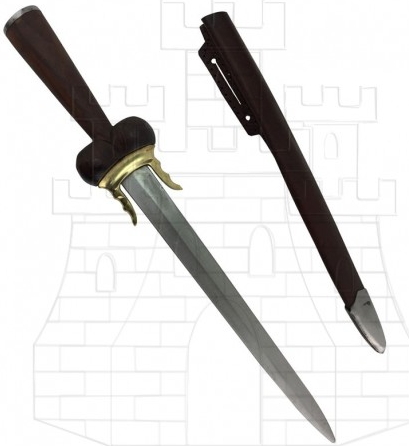 One of the most notable characteristics of testicular daggers was their extraordinary geographical distribution and their ability to transcend social class divisions, something uncommon among specialized medieval weapons.
One of the most notable characteristics of testicular daggers was their extraordinary geographical distribution and their ability to transcend social class divisions, something uncommon among specialized medieval weapons.
European expansion
Although its exact origin is debated, archaeological and documentary evidence indicates that testicular daggers emerged in the late 13th century in the region comprising England, Flanders, and Scotland. From there, they spread rapidly:
- Scandinavia: They became the most common type of dagger in the Nordic countries during the 14th and 15th centuries, with numerous examples found in Denmark, Norway, and Sweden.
- British Isles: They maintained their popularity in England and Scotland during the Tudor and Stuart periods (16th-17th centuries), eventually evolving into the Scottish dirk.
- Continental Europe: They spread to France, Germany, the Netherlands, and other regions, albeit with regional variations in design and use.
Democratization of weaponry
Unlike many medieval weapons that were restricted to specific social classes, the testicular dagger was truly democratic:
- Knights and nobles: They carried it as a reserve weapon and status symbol, frequently with richly decorated hilts.
- Soldiers and men-at-arms: They used it as a practical and reliable combat tool.
- Peasants and artisans: They primarily used it as an everyday tool and self-defense weapon.
- Merchants and travelers: They considered it essential for personal protection on dangerous roads.
This universality of use contributed significantly to the longevity of the design. While other specialized weapons fell out of use when military tactics or aristocratic fashions changed, the testicular dagger maintained its relevance because it served multiple purposes for multiple social groups.
Evolution and legacy: from the medieval dagger to the Scottish dirk
Like any successful weapon, the testicular dagger did not remain static throughout its five centuries of use. Its design gradually evolved, adapting to changing military needs, aesthetic preferences, and technological developments.
Morphological transformations
Analysis of surviving examples reveals a clear chronological evolution:
- 13th-14th centuries (early form): Wide conical hilts with large and prominent protuberances. Relatively short but robust blades.
- 15th century (classic form): Refinement of the design with more elaborate hilts, often carved from bone or exotic wood. The protuberances maintain their prominence but become more stylized.
- 16th-17th centuries (late form): More slender hilts, less prominent lobes. Greater emphasis on decoration and status symbolism. Slightly longer blades.
- 18th century (transition): Gradual evolution towards the Scottish dirk, which maintains the general shape but with almost vestigial lobes and longer, more elaborate blades.
The persistent legacy
Although the testicular dagger in its classic form ceased to be mass-produced in the 18th century, its influence persisted:
- The Scottish dirk: This ceremonial and combat weapon, still used in traditional Scottish uniforms, is the direct descendant of the medieval testicular dagger.
- Collecting and historical reenactment: Today, replicas of testicular daggers are highly valued by collectors, practitioners of historical European martial arts (HEMA), and medieval reenactment enthusiasts.
- Cultural symbol: The testicular dagger has become an icon of medieval weaponry, appearing in museums, films, television series, and video games set in the Middle Ages.
Historical authenticity in modern replicas
Quality contemporary replicas seek to maintain the authenticity of historical examples:
- Traditional materials: Use of carbon steel for blades, authentic wood (preferably root wood) for hilts, and hand-stitched leather for sheaths.
- Forging techniques: Some specialized manufacturers use traditional forging methods to recreate the metallurgical characteristics of medieval blades.
- Historical details: Attention to elements such as the exact shape of the protuberances, the blade profile, and surface finishes that correspond to specific historical periods.
Testicular daggers represent much more than a medieval weapon with a peculiar name. They are a testament to pragmatic medieval engineering, to the ability of a design to adapt and survive through centuries of technological and social changes, and to how a functional object can simultaneously become a cultural symbol and a personal statement.
From the battlefields of the Hundred Years’ War to the belts of Hanseatic merchants, from aristocratic courts where they were displayed as status symbols to farms where they served as everyday tools, testicular daggers accompanied Europe through its transformation from the Middle Ages to the Renaissance. Their unmistakable shape, which made Victorian historians blush but which medieval warriors proudly carried, reminds us that functionality, symbolism, and craftsmanship can combine in an object that transcends its era to become a legend.
Today, when we hold an authentic replica of a testicular dagger, we not only hold a historical weapon: we hold five centuries of European history, the skill of countless artisans, and a design whose effectiveness and symbolism were so powerful that they defied the passage of time and changing fashions. Few weapons can boast such a legacy.
VIEW TESTICULAR DAGGERS | VIEW HISTORICAL DAGGERS | VIEW OTHER PERIOD DAGGERS
